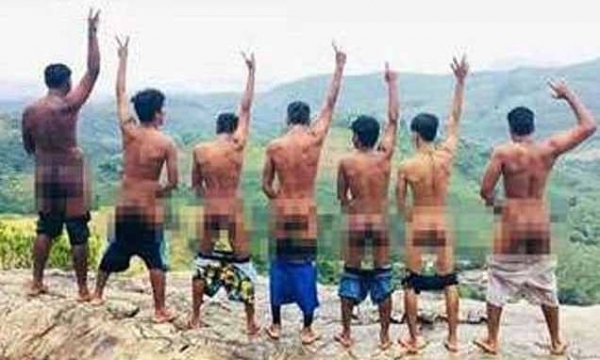By Rasika Jayakody
A bunch of post-A level hikers climbing the rock of Pidurangala and posing for a picture with their rear-ends to the camera grabbed headlines, last week.
The society-at large, understandably, was enraged at their gesture as the Pidurangala rock, located nearly 2 km away from Sigiriya, was home to venerated Buddhist monks in ancient times.
The hikers savoured bitter consequences of their action when they were promptly arrested by the Police reportedly under the law against obscene publications, as they had posted their pictures on social media. The Dambulla magistrate remanded them for two weeks pending further inquiries..
In addition to these post-A/Level hikers, many others in Sri Lanka too experienced their ‘Pidurangala moment’, twice, within a matter of few days. The first encounter was when President Maithripala Sirisena addressed the UN General Assembly where he categorically said the Sri Lankan armed forces had not committed war crimes or international humanitarian law violations during the last stages of war. He also urged the world leaders to let Sri Lanka handle her own problems, within her own systems.
Was there any local or internationally-sponsored investigation to backup President Sirisena’s claims? Absolutely not. Not even a single meaningful step has so far been taken by the current government to initiate such an investigation that would support Sri Lanka’s claims of zero war crimes. The UNHRC has repeatedly expressed its concern over the lack of progress made by Sri Lanka in addressing war crimes and issues of human rights violations. Therefore, the Sri Lankan President’s words hardly carried any weight in the eyes of many world leaders gathered at the summit.
But, by making this statement, the President gave a glimpse of ‘Pidurangala’ to many Yahapalana symapthizers who chose to back the government, despite many a debacle, with the fervent hope that it would at least mete out justice to the victims of war. This includes the likes of Sumanthiran, the TNA MP, and many other Colombo-based civil society and NGO activists who constantly overlooked many a Yahapalanaya folly with a larger objective in mind . The President’s statement at the UN crystallized that there would be no war crimes investigation - domestic, foreign or hybrid - under the current government, for the next one and a half years.
The President’s subsequent remarks to the Sri Lankan community in New York signaled that he had now taken a 180 degree turn from his position in January 08, 2015 - the day many considered to be a landmark in post-independence history. Instead of adopting measures towards ‘healing’ and living up to the promises of ‘Yahapalanaya’, President Sirisena went on to say that it was he, as the Acting Minister of Defence at the time, who led the final military onslaught on the LTTE.
Sirisena said he was entrusted with the task of acting as the Defence Minister during the last two weeks of the battle as the top-brass leaders of his camp had fled Colombo due to fears of possible air attacks by the LTTE. Although the President’s remarks drew a scathing attack from Field Marshal Sarath Fonseka, a minister in his own administration, it made it clear that there would never by a serious attempt by the current government to revisit what went wrong during the last stages of the battle and ‘seek truth’. This means those who crusaded against the Rajapaksas and supported Sirisena in pursuit of justice to the victims of war are now caught up between a rock and a hard place.
The second incident took place courtesy the Prime Minister who, according to his office, ordered the Police to investigate into the photographs posted by the Pidurangala hikers on social media. By arresting a bunch of young hikers for taking pictures of their rear-ends and putting them through prosecution, the country’s law enforcement bodies demonstrated that they could not make a differentiation between youthful folly and a criminal offence.
While many believed that the act of the young hikers was utterly inappropriate, no one believed it warranted criminal prosecution under archaic legislations. This disproportionate action by the Police was an act of showing rear-end to the liberals who supported ‘Yahapalanaya’ against the crushing military state which the Rajapaksas were in the process of devising.
The Police which burst into action and remanded the group was the same institution which could not arrest Admiral Ravindra Wijegunaratne, the Chief of Defence Staff, for shielding the main suspect in the abductions and killings of eleven youth. It shows that the Police and those directing the law enforcement system have seriously mixed up their priorities. This is far from the kind of governance the country expected when they elected the current administration in January, 2015, through, according to the propaganda arm of the government, a 'silent resolution'.
It is not clear to this writer as to how the government plans to recover from the morass it has sunk to, before the next national election. But, if and when it does, the government will no doubt cringe at its own ‘Pidurangala moments’, which its leaders could have easily avoided had they acted with a little more judiciousness.




